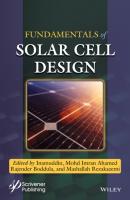Fundamentals of Solar Cell Design. Rajender Boddula
Чтение книги онлайн.

Читать онлайн книгу Fundamentals of Solar Cell Design - Rajender Boddula страница 26
Название: Fundamentals of Solar Cell Design
Автор: Rajender Boddula
Издательство: John Wiley & Sons Limited
Жанр: Физика
isbn: 9781119725046
isbn:
(2.4)
2.2.2 Mechanism of Plasmonic Solar Cells
Plasmonic nanostructures are used as light harvesting antennas in thin film solar cells. Plasmonic nanostructures such as metallic nanoparticles or thin films are used to trap or concentrate light. They can be introduced at top or back surface as antireflecting coating in solar cells. Various fabrication techniques can be used to deposit metal nanoparticles. A simple technique is the evaporation followed by heat treatment for making arrays of metal nanoparticles. The lithography is also used for making metal nanoparticles [36, 37].
Figure 2.4 Approaches to integrate plasmonic nanoparticle in solar cell.
Plasmonic nanostructures can be used mainly in three manners. First, they can be positioned at the top surface as subwavelength scattering element in solar cell as shown in Figure 2.4a. The metallic nanoparticles dielectric particles are used to get scattering. Metallic nanoparticles are preferred because they can scatter more light than their geometry area. Second, a plasmonic nanostructure can be embedded at the interface or inside the absorber as shown in Figure 2.4b. The plasmonic resonance scatters the light inside the absorber layer and increases absorption at the interface. This design is more preferred in DSSC and single junction PV device. Third, the metallic nanostructure can be positioned as array of nanoparticle or very thin film at the back surface in solar cell as shown in Figure 2.4c. The light travels in a longer path and enhances the absorption. The plasmonic thin film does the task of light trapping and collection of charge carriers [38–40].
2.3 Important Optical Properties
The plasmonic nanostructures are mainly used for increasing light absorption through scattering in plasmonic solar cells. The plasmonic nanostructures are affecting to optical properties such as light trapping, absorption, scattering, resonance wavelength range, and energy levels.
2.3.1 Trapping of Light
The metal nanoparticles are normally placed at a particular distance for trapping enough sunlight between nanoparticle and substrate in solar cell. The illuminated light intensity decreases with distance from the substrate in the case of embedded plasmonic nanoparticle. The top deposited plasmonic nanoparticle design is advantageous for illuminated light into the substrate. The more light escapes from device if there is no distance between the substrate and particle. The absorption is enhanced by folding light in absorber using plasmonic nanoparticles. The folding of light is mainly depending on the structural properties of metallic nanoparticles. The absorption is large in small nanoparticles because of increased near-field. However, very smaller metal nanoparticles go through ohmic loss. Hence, the surface plasmons can be utilized to improve the electric and optical behavior of solar cells. SPRs have ability to collect about 95% incident light where as conventional solar cell can collect about 30% of sunlight [41].
2.3.2 Scattering and Absorption of Sunlight
The absorption and scattering of incident sunlight are main affecting parameters on the efficiency of solar cells. The utilization of plasmonic nanostructures at the top surface of the PV device improves the overall absorption through the scattering of light. For example, silicon does not absorb much light and hence more lights need to be scattered to increase the absorption. The deposited silver metal nanoparticles at the surface increases the absorption and scattering due to surface plasmons is about 10 times more than the nanoparticle. A broader plasmon resonance can be achieved in metal nanoparticles with a large scattering [42].
2.3.3 Multiple Energy Levels
The multiple energy levels are possible by designing the stacks of solar cells on top of each cell with a different energy band gap to increase the absorption of light. The stacked structure of PV cell utilizes maximum sunlight and produces maximum energy conversion efficiency. The each cell should have same lattice parameters to decrease the energy losses [43]. The energy band gap values are summarized for various materials with their maximum absorption wavelength in Table 2.2. The band gap energy vs. λmax curve for different photoactive materials is shown in Figure 2.5.
Table 2.2 Energy band gap of various absorber and metal nanoparticles.
| Material | Energy band gap (eV) at 300K | λmax (λ = hc/E = 1242/E) nm |
| Ge | 0.66 | 1,881 |
| Si | 1.11 | 1,118 |
| InP | 1.27 | 977 |
| CIGS | 1.42 | 874 |
| GaAs | 1.43 | 868 |
| CdTe | 1.44 | 862 |
| CZTS | 1.5 | 828 |
| CuO | 1.7 | 730 |
| CdSe | 1.74 | 714 |
| BiFeO3 | 2.09 | 594 |
| Fe2O3 | 2.1 | 591 |
| GaP | 2.25 | 552 |
| CdS | 2.25 | 552 |
| PbO | 2.9 | 428 |
| TiO2 | 3.2 | 388 |
|
SrTiO3
СКАЧАТЬ
|